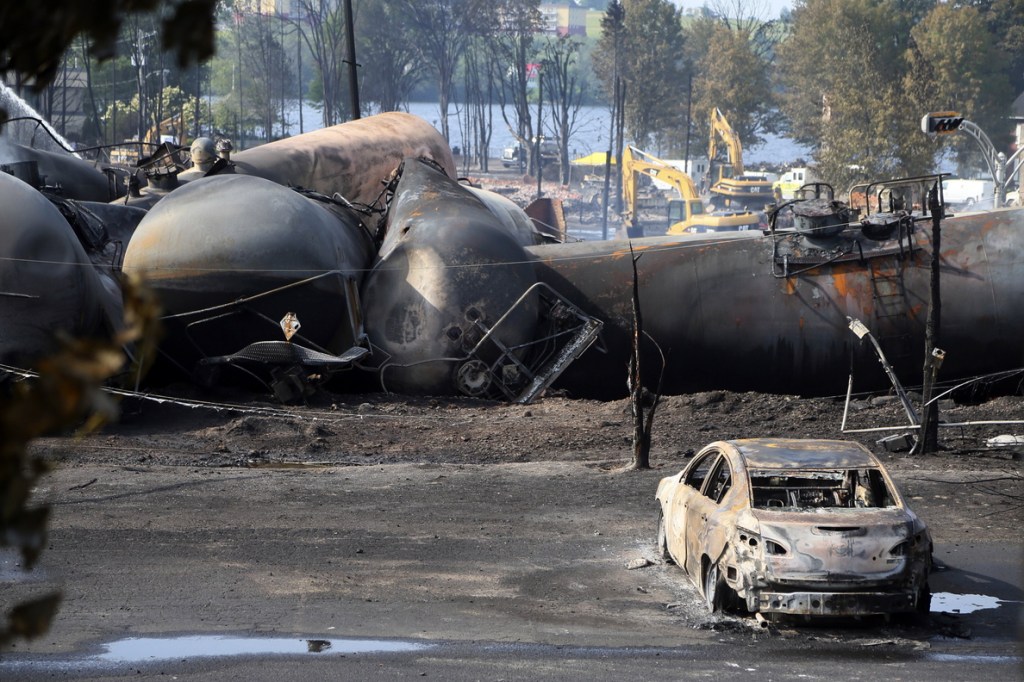OMAHA, Neb. — Proposed new safety standards for rail cars that haul flammable liquids gained support from U.S. railroads Thursday, but it’s not yet clear whether the companies that own most of those cars will support the upgrades to prevent leaks.
The Pipeline and Hazardous Materials Safety Administration is considering a plan intended to fix a dangerous design flaw in a rail car commonly used to haul oil and other hazardous liquids from coast to coast.
Safety experts say the soda-can shaped car, known as the DOT-111, has a tendency to split open during derailments and other major accidents.
Concerns about the tank cars are higher now because of the fiery train crash in July in Lac Megantic, Quebec — near the Maine border — that killed 48 people and because railroads are hauling significantly more crude oil.
U.S. railroads are supporting new safety standards for rail cars that haul flammable liquids to address flaws that can allow crude oil, ethanol and other substances to leak during accidents.
The Association of American Railroads said Thursday that railroads support making upgrades to the fleet of 92,000 tank cars that carry flammable liquids. Of those, 14,000 cars are newer cars built to current safety standards.
“We want to aggressively move on phasing these out,” said Ed Hamberger, president of the railroad trade group, said of the older cars.
Hamberger said the new standards can help make the tank cars even safer than they already are, but better cars are only one part of the overall effort to ensure safety.
Nearly 5.3 million barrels passed through Maine last year on the way to a refinery in Saint John, Brunswick. Oil shipments by rail in Maine has been on the rise as market forces make Maine a waypoint for oil extracted from the Bakken oil fields in North Dakota.
Chop Hardenbergh, a Freeport resident who publishes an industry newsletter, Atlantic Northeast Rails & Ports, speculated on Thursday that railroads might benefit from higher tanker standards because it would lower the risk of major accident and also their insurance rates.
“It helps not only public perception but potentially their bottom line,” he said. “They can’t have another Lac Megantic.”
It is an opportune time to improve safety standards because many oil producers and refiners are investing in new cars to handle the surge in domestic oil production. The number of carloads of oil railroads are delivering jumped to 233,811 last year from 10,000 in 2009, and in the first nine months of 2013, railroads delivered 319,901 carloads of oil.
Railroads generally don’t own the tank cars. The oil and chemical companies that own them will also likely comment on the proposed rule before the agency’s Dec. 5 deadline. Public comments on the proposed safety rules are also welcome and may be submitted online.
An agency spokeswoman said officials want to gather as many comments as possible. A final rule isn’t expected until next year.
The proposed changes include requiring cars to have a thicker steel shell, better heat protection and better protection for valves on the tank cars. The rules would also require high-capacity relief valves and new designs to prevent outlets on the bottom of the car from opening during an accident.
Defects in the DOT-111 tank car’s structure were noted as far back as 1991.
Last year, The Associated Press reviewed 20 years of federal rail accident data involving DOT-111 cars used to haul ethanol and found that the cars had been breached in at least 40 serious accidents since 2000. In the previous decade, there were just two breaches.
The AAR says there are 228,000 DOT-111 cars in the fleet of 335,000 active tank cars. Of those, only 92,000 are used for flammable liquids like crude oil and ethanol.
The industry adopted voluntary standards ensuring that all DOT-111s ordered after October 2011 meet tough requirements recommended by the National Transportation Safety Board, following a 2009 crash outside Rockford, Ill., that killed a woman and injured 11 others.
That means about 78,000 of the cars that carry flammable liquids were built to older standards.
The NTSB has said the older DOT-111 cars have a steel shell that is too thin to resist puncture in accidents, and the ends of the car are vulnerable to ruptures. Valves used for unloading and other exposed fittings on the tops of the tankers can also break during rollovers.
The railroad trade group said about 30 percent of the tank cars being used to move crude oil today meet the 2011 voluntary standards the industry adopted.
New safety regulations could be drafted as early as December 5 that could have “game-changing consequences” for tank car manufacturers and strong ripple effects on the rail and energy industries, according to Cowen and Company, an investment banking firm that on Thursday said held an industry conference on shipping crude by rail.
According to the bank, the worst-case scenario would be a mandate requiring retro fitting existing fleets with “jacketing,” a process is so costly and time-consuming that would render much of the fleet almost obsolete.
Staff Writer Tom Bell contributed to this story.
Send questions/comments to the editors.


